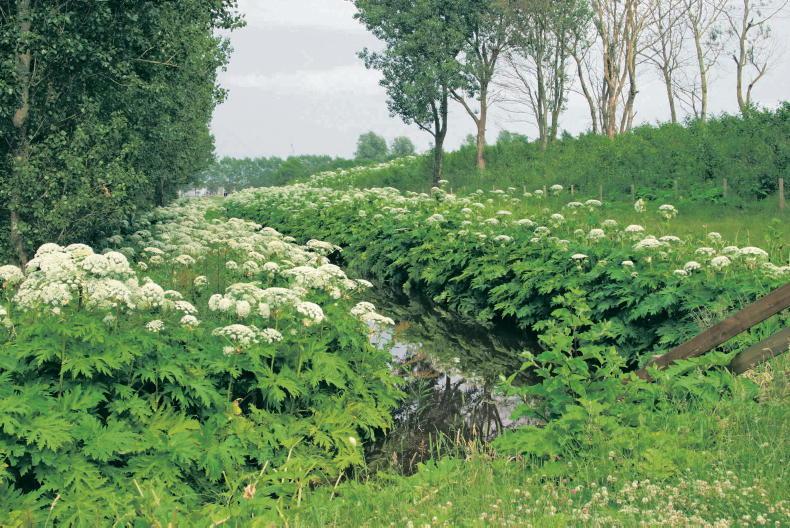Farmers are being urged to report any giant hogweed infestations on their land and to join a scheme to help eradicate the invasive species.
The Irish Farmers Journal attended a Farming for Water EIP meeting held in Cappawhite, Co Tipperary last Thursday evening about the non-native plant which poses a threat to human health.
It is widespread in Northern Ireland and is becoming locally abundant in the rest of the island, most commonly on shorelines as the seeds flow downstream.
Local Authority Waters Programme regional manager, Anthony Coleman said there needs to be 100% uptake of actions to control the weed or else the scheme will not succeed.
“You would only be throwing away good money,” he said.
“We need to get everyone [on the course of a river] involved and show that this is going to work.”
Treatment
The Farming for Water project team anticipates that the management of the infestation will take many years and will need full co-operation from farmers.
The programme plans to hire professional contractors to remove the species from the area and teach locals to monitor and manage the plant for the next decade.
Giant hogweed seeds can remain viable for up to 15 years after initial dispersal and can be spread by wind, water
or animal and human influence.

Giant hogweed is widespread in Northern Ireland and is becoming locally abundant in the rest of the island, most commonly on shorelines as the seeds flow downstream.
“It would be a systematic approach, starting at the top and do a treatment programme for a number of years to try and get a handle on it.
“Otherwise, this plant is only going to spread further and create a bigger problem,” added Coleman.
Giant hogweed is a threat to human health
The invasive species is known to pose a threat to human health due to its hazardous sap which, once it comes in contact with human skin, can cause severe burns that might need medication to treat.
These severe burns are known to cause scarring and the skin can remain sensitive to sunlight for many years afterwards.
In addition, the plant is also a risk to ecosystems as when the plant dies off in winter, it can lead to land erosion and for agricultural run-off to escape more easily into water sources.
Identify
Giant hogweed is easily identifiable due to its height, growing up to 6m high. The plant’s stem is thick, green with purple blotches and covered in hairy bristles while the inside is mostly hollow.
The flowers of the plant, which blooms between June and August, are white. It also produces large serrated leaves which can be 3m long and 1.5m wide.

A Farming for Water EIP meeting held in Cappawhite, Co Tipperary Thursday evening, 24 October about a local giant hogweed infestation. / James Hanly
Farmers are being urged to report any giant hogweed infestations on their land and to join a scheme to help eradicate the invasive species.
The Irish Farmers Journal attended a Farming for Water EIP meeting held in Cappawhite, Co Tipperary last Thursday evening about the non-native plant which poses a threat to human health.
It is widespread in Northern Ireland and is becoming locally abundant in the rest of the island, most commonly on shorelines as the seeds flow downstream.
Local Authority Waters Programme regional manager, Anthony Coleman said there needs to be 100% uptake of actions to control the weed or else the scheme will not succeed.
“You would only be throwing away good money,” he said.
“We need to get everyone [on the course of a river] involved and show that this is going to work.”
Treatment
The Farming for Water project team anticipates that the management of the infestation will take many years and will need full co-operation from farmers.
The programme plans to hire professional contractors to remove the species from the area and teach locals to monitor and manage the plant for the next decade.
Giant hogweed seeds can remain viable for up to 15 years after initial dispersal and can be spread by wind, water
or animal and human influence.

Giant hogweed is widespread in Northern Ireland and is becoming locally abundant in the rest of the island, most commonly on shorelines as the seeds flow downstream.
“It would be a systematic approach, starting at the top and do a treatment programme for a number of years to try and get a handle on it.
“Otherwise, this plant is only going to spread further and create a bigger problem,” added Coleman.
Giant hogweed is a threat to human health
The invasive species is known to pose a threat to human health due to its hazardous sap which, once it comes in contact with human skin, can cause severe burns that might need medication to treat.
These severe burns are known to cause scarring and the skin can remain sensitive to sunlight for many years afterwards.
In addition, the plant is also a risk to ecosystems as when the plant dies off in winter, it can lead to land erosion and for agricultural run-off to escape more easily into water sources.
Identify
Giant hogweed is easily identifiable due to its height, growing up to 6m high. The plant’s stem is thick, green with purple blotches and covered in hairy bristles while the inside is mostly hollow.
The flowers of the plant, which blooms between June and August, are white. It also produces large serrated leaves which can be 3m long and 1.5m wide.

A Farming for Water EIP meeting held in Cappawhite, Co Tipperary Thursday evening, 24 October about a local giant hogweed infestation. / James Hanly









 This is a subscriber-only article
This is a subscriber-only article









SHARING OPTIONS: